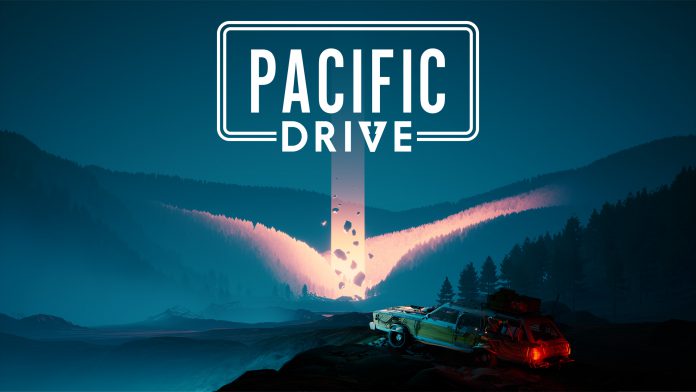What’s the worst that could happen on a car trip up the scenic Washington state coast? Pacific Drive aims to let you find out. Far from a cozy walking simulator or a slow-paced, iterative survival game, the first offering from developer Ironwood Studios is a mean, crafty, anxiety-inducing run-based survival game, where players constantly have to weigh scavenging the materials to upgrade their ride against escaping with enough of their station wagon and themselves intact to justify the cost.
Here is the logline pitch: In the late seventies, a mysterious super-science technology that could warp the very fabric of reality was discovered on the Olympic Peninsula in the American Pacific Northwest. Initial corporate research into the macguffin was promising, leading to utopian dreams of free energy or the end of material scarcity; these dreams disappeared into a haze of distortion and hallucination as the nightmare technology consumed the peninsula and permanently unmoored its geography from reality. The government built a giant wall around it and sealed it off, as you do. Some twenty years later in 1998, you, a private courier, arrive at the wall to make an unexplained, un-routine delivery of unknown provenance, and find yourself torn through a hole in reality into the Zone. Some elements may seem familiar here; the game is titled Pacific Drive, but there’s a reason some players have taken to calling it S.T.A.L.C.A.R.
The initial trailer is a fun, upbeat, high-tempo, vroom-vroom affair:
It does depict things you will be doing in game, and it does a good job of selling you on thinking of those things as cool, but there is one specific way in which it is misleading: You will not be spending much of your time in this game moving over 25 miles per hour in that station wagon. Eventually, yes, starting in the mid-game there will be certain highway sections that will let you get up to speed; once your station wagon is fully upgraded, hitting those speeds on normal maps won’t even be that difficult. But the gameplay loop for Pacific Drive at the beginning, and at least through to where I’ve played in release week (the Mid Zone, which is, fittingly, the mid-game) figures the station wagon not as a speed demon, but as a tank — a slow-moving temporary base that shields you from the worst and most dangerous things in the environment and whose primary concern is positioning, not landspeed.
I’ve recorded 20 minutes or so of gameplay footage from the second story mission of the game, preceded by the intro and a tutorial map. At this point in the story, Oppy, the old tutorializing lady with a secret, unstated past, has led you to a great anomaly in the middle of a town that was trapped in the Zone and for various reasons needs you to drive your car directly into it. To do that, you need to get height, so you need to make your way to a bridge up on a nearby cliffside. What follows is my attempt to get there, in the process going through almost all the features of traversing a Pacific Drive map while out on a run:
This hits all the key points: Seeing a wreck on the side of the road and stopping to dismantle it for crafting parts; trying to refuel the station wagon at a gas station infested with creepy statue-people called Tourists who are essentially landmines; going one way around the great crater in the center of town, deciding I’ve gone the wrong way, and circling back around the other direction; having to get out and jumpstart a dead battery; and finally deciding to just head off on a dirt access road to the highest ground possible, so that when I can see the bridge where I’m supposed to be below me, I can just brutalize the station wagon’s transmission with an extremely ill-advised slalom down the hill.
Navigating the maps in Pacific Drive will routinely turn into these kinds of adventures — and the entire time, there will be weird, dangerous traps and monsters collectively referred to as Anomalies roaming the woods and patrolling the streets. You get to see a bunch of them in there; the star of this particular show are the Left-Rights, those spinning red and blue vortexes that grab your car, hit your accelerator, turn the wheel in a random direction and send you off on your way. Depending on the terrain around you, this can either effectively or quite literally end your run, as it’s very possible for it to send you careening off a cliff. Far from fast racing-type gameplay, the majority of your time spent out in the station wagon will be spent moving at a measured pace, keeping your eyes out for Anomalies and trying to avoid them. And there are just so many of the damn things.
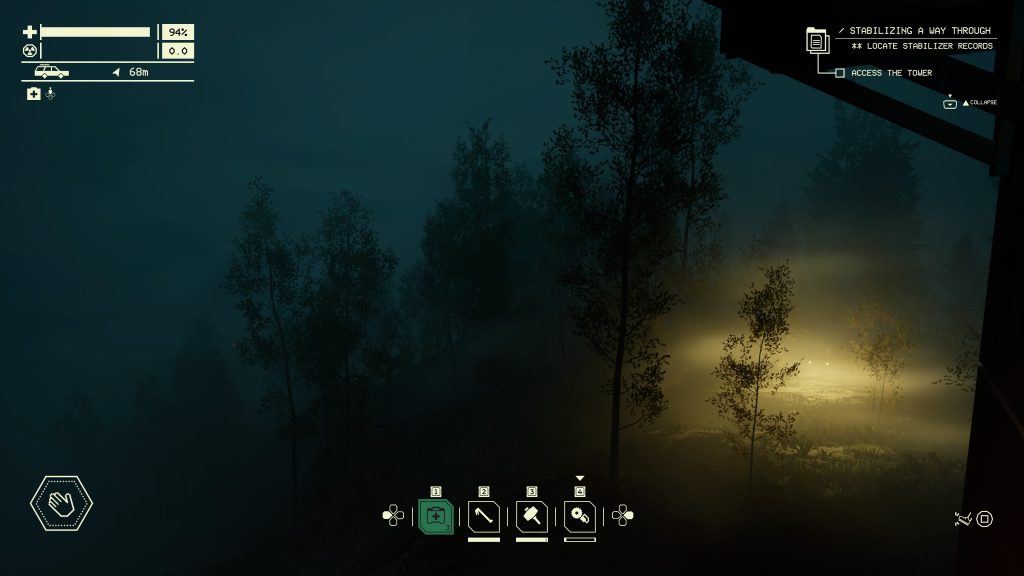
None of this is inherently negative; it certainly wasn’t for me. I’m very much enjoying my time with Pacific Drive, and the complaints that I do have concern the between-run “meta progression” more than they concern the core play loop itself. But you’re going to be spending a whole lot of your play moving very slowly, carefully driving 15 miles per hour around constant Anomalies wandering through the road, and stopping every couple hundred feet to loot an abandoned car or a darkened research trailer or a dingy emergency cabin. It’s methodical and very atmospheric, but not at all cozy, and far from mindless — you can’t really switch your brain off and start looting cabins while listening to a podcast or something, because an Anomaly or environmental hazard will wander in and zap you up real quick.
Until you reach the end of a run, of course. Then things start going real fast and all hell breaks loose. To successfully end a run of Pacific Drive, you need to activate the exit portal to the map (the “Gateway”), and then do something like this:
Note that I’m still not moving all that fast because this is the third plot mission of the game and I’m still using the crappy little beginning engine that tops out around 40 miles per hour. That does eventually go up, and you will want that upgrade as soon as you can, because the Gateway mechanic takes inspiration from that staple of battle royale shooters since the heyday of PUBG: the circle. Once the Gateway appears, the map starts breaking down around you, and you have to race a closing circle of stable reality to the pillar of light in the sky and drive the station wagon into it to escape. In this map, there’s one Gateway with a static location (and I could have planned what order I hit the objectives in better if I’d known where that was ahead of time); in maps on regular runs, you will usually get to choose between a couple different Gateway locations, which you’ll activate using Anchors, which are little orbs located around the maps that you feed to your car both to power up the “escape map” button (because you cannot leave without a Gateway) and to act as meta-currency for unlocking new stuff back at base.
Getting to the Gateway is a wild ride. If you’re going to die on a run, you’re probably going to die here. My one failed run so far was a variant on a Gateway escape — I dawdled around on a map way too long looting buildings and ignoring the weather going insane around me, sending in storms and minor versions of the circle and so on, and eventually the entire map was covered in “you take damage whenever you’re outside” laser fog. I had to find an Anchor and activate a Gateway while the car was breaking down around me; in the end my tires gave out while being asked to off-road (there are tires in the game that are made for off-roading, but these were not those) and everything went red, and then black.
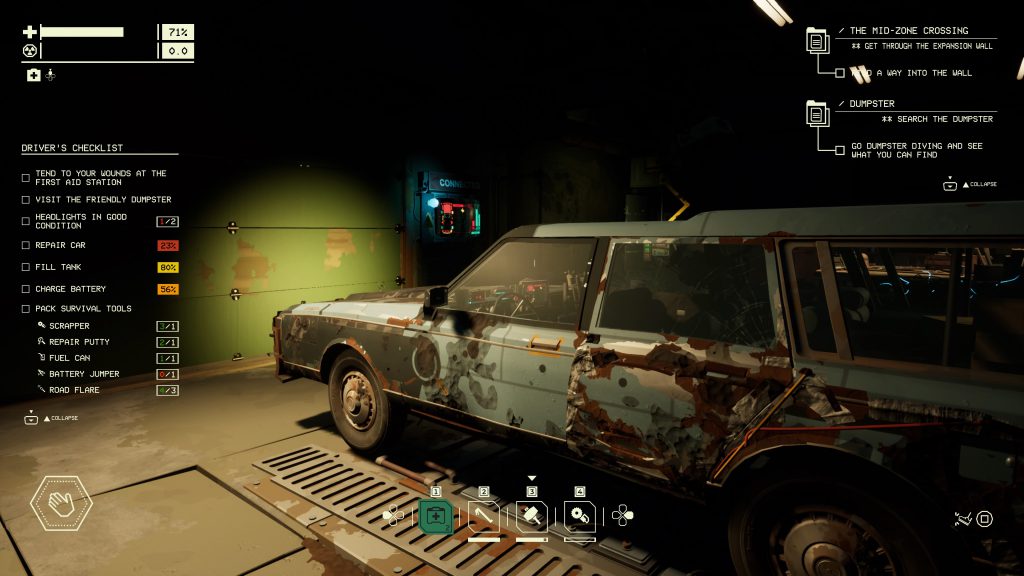
Then the game spit me back out at the garage with a completely destroyed car that needed all its panels, doors, headlights, and three wheels replaced, and nothing in the trunk but my scrapper and a crowbar, and now we’re going to engage with the actual complaint I have about Pacific Drive: the default difficulty is tuned exceptionally high, and if it’s going to be tuned that high, the default outcome of a failed run can’t be “destroy most of the car, destroy all of your salvaged loot, and roll some dice to figure out which of your tools also get destroyed.” Destroying the car — fine; that’s what factually happened in the run, after all. Destroying the loot — more than fine; that’s what the penalty for failing in any kind of run-based game should be; you don’t get to keep the stuff you picked up. Destroying your tools, however, makes it harder to impossible to fix up the car and, since your tools are made out of stuff you looted, is a tax on previous runs you succeeded on, not merely the one you just failed. A failed run with the default difficulty settings doesn’t just mean you didn’t move forward in your attempts to upgrade the station wagon but it significantly-to-catastrophically sets you back, as you have to spend significantly from supply reserves that may not exist to enter the next run with anything except the minimum viable station wagon.
There are two ways the game has to mitigate or correct for this, one of which is far more elegant than the other. The in-game solution, which is almost charmingly clunky and cludgy, is the Friendly Dumpster. This guy.
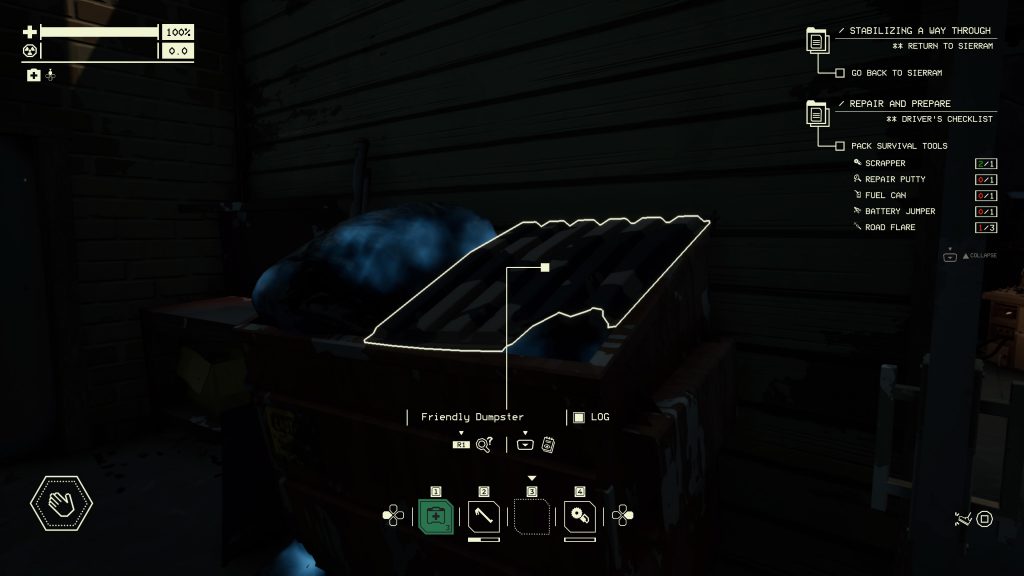
There’s a dumpster at the garage, and when you interact with it, it’ll burble and flumph, and then it’ll vomit out a selection of parts and materials that the game thinks you need to get your station wagon back to a baseline level of repair to attempt one of the easier maps in the game. It’s far from perfect in its judgment and sometimes you have to pester it a couple times to get everything it wants to give you, but it’s usually helpful enough that with some luck on your next run, you’ll be back on your feet. Short runs take 20-30 minutes and longer runs that have you driving through multiple zones on your way to your destination can easily clear an hour in length, so that’s not nothing in terms of time investment, but it is what it is.
The far more elegant solution is the dang Gameplay menu.
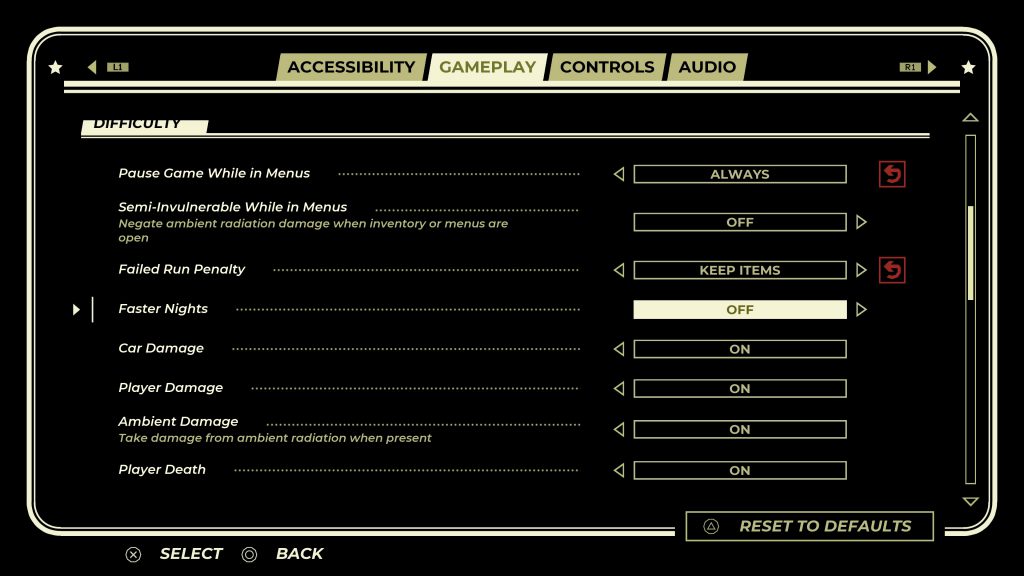
Here you can see what I have as my settings under the Difficulty subheader; I have the game pause in menus both as a matter of ideology and because as an adult with responsibilities I sometimes have to go do something so urgently that I need every kind of menu to pause the game, not just the system menu (which always pauses the game). More importantly, I have the failed run penalty set to keep items. Now, this isn’t a perfect solution: I really do feel like I shouldn’t keep the loot on a failed run, just the tools. But given the choice between how the default “keep some items” option is implemented and this, I’ll take this. Additional good news: I spoke to designer Seth Rosen on Bluesky about this, because the devs for this game are wonderfully responsive, and when they get a moment to catch their breath after launch some sort of “keep crafted items only” option will find its way into this menu.
You can see from the screenshot that this list is quite expansive and can radically change and lower the difficulty of the game; there’s a much cozier version of this game that still has some mild danger to it where you turn off car damage, turn off ambient damage, and keep player damage on so you do in fact have to respect the Anomalies themselves when you’re out and about. And what you can’t see are the two additional full lists of settings below this, Realism and Modifiers, that let you tweak how forgiving or how punishing specific tasks or environmental settings are in the game. Pacific Drive presents itself at its highest difficulty out of the gate, and lets you turn it down to the specific ways it suits you. The instability storms that caused me to flee in my failed run? You can turn those off. The storms brought down by the Gateway in that run that actually killed me? You can turn them off, too.
But outside of the specific thing that I, ah, complained to the developers about on social media and got them to change (hey look pal, Seth found me not the other way around), I haven’t found much reason to avail myself of these settings. I think the standard difficulty is mostly correct; it makes the Zone feel dangerous and it makes success feel earned. I might have gone a bit more sparse on Anomaly density in the easier zones; there’s not really a setting for that. Setting aside those pretty minor things, though, I’ve enjoyed my time in the Olympic Peninsula Exclusion Zone.
Update, 2/29: As Bluesky user matt.bailey.run points out, the game could also use some kind of “save and quit” mode within each run, similar to what a lot of other longer run-based rogue-lites have. It’s not as big an issue for PS5 users due to the Rest Mode feature on that console, but on PC your only real option is to leave the game running in the background while you take care of whatever emergency of modern life has just popped up.
Final Verdict: Controls well, which is important in a first-person driving game. It’s always obvious when your car’s lack of response is due to it not being very good at, say, driving off-road or going up inclines, or because you’ve popped your front tires. Looks great and runs great on the PS5; especially good lighting, which is becoming easier and easier for small teams to pull off given the tech advances around that stuff. Might have some issues in the late game with repetitiveness once you’ve been doing the core loop for 20 hours (a very realistic target for late game; it took me six hours to reach the Mid Zone without upgrading my ride much at all). That sort of comes with the territory in run-based games, however, and at a $29.99 price point on PC and PS5 there’s more than enough content here to justify the spend. Strong recommendation.
If you have any questions or comments feel free to drop us a note in the Comments below or email us at contact@goonhammer.com. And if you want regular updates in your inbox, subscribe to our newsletter.
